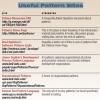|
Measuring Up You measure because you want to make better-informed decisions. But even simple, harmless-looking measures can be dangerous. For example, they can give you a nice, clear picture of an illusion. Do you want to base your decisions on illusions? Technical Editor Brian Lawrence advises that, before you dive into measuring anything, ask yourself, "Will measuring do more harm than good?" |
Brian Lawrence
June 26, 2002 |
|
|
The Wonderful World of Software Former STQE magazine Technical Editor Brian Lawrence shares a tale about why a commitment to quality and paying close attention to detail are critical elements in building better software. It’s all about careful planning and anticipating customer behavior. Go with Brian on a stroll through one of the oldest, best-known amusement parks to find out more. |
Brian Lawrence
June 26, 2002 |
|
|
How Do You Build the Right Software Right? Technical Editor Brian Lawrence explains his top-three list of things to do to deliver the right software right: risk-based planning, problem definition and modeling, and congruent leadership. |
Brian Lawrence
June 26, 2002 |
|
|
I Think, Therefore I Prototype Prototypes can help you deliver the right software. Here, Technical Editor Brian Lawrence gives examples of prototypes and some guidelines for prototyping. |
Brian Lawrence
June 26, 2002 |
|
|
The Ariane 5: A Smashing Success On June 4, 1996, the maiden flight of the Ariane 5 satellite launcher ended spectacularly after only forty seconds, with bits of the $67 billion vehicle and its payload spread over a fairly large part of French Guiana. The report issued July 19 by the International Inquiry Board noted that the fiery crash was due to a "chain of technical events." The details of that particular chain of events are reviewed here. |
Les Hatton
June 26, 2002 |
|
|
How to Survive the Software Swamp For a project to make long-term progress, it must build a platform of basic engineering practices. On this platform are set the ladders of advanced techniques that you select using risk analysis. Properly managed, these processes help you avoid falling back into the swamp whenever the project is under pressure. |
Michael Deck
June 26, 2002 |
|
|
|
A Look at Rational SQA Robot Noel Nyman continues sharing his experiences of working in the Microsoft WindowsNT Group, where he evaluated several automation tools for the Applications Test team. This is the second installment in a series. |
Noel Nyman
June 26, 2002 |
 |
Finding Patterns in Software "Patterns" have caught on among software designers, especially those working on object-oriented systems. More recently, patterns have been applied to organizational behavior, including patterns for organizing independent test groups. Brian Marick provides Web resources on the study of patterns. |
Brian Marick
June 26, 2002 |
|
Interviewing Your Interviewer Job interviews are stressful. Often, people are so eager to impress the interviewer that they don't find out critical information about the company and the position. But it's just as important for you to be convinced of the position's suitability for you as it is for the company to be convinced of your suitability for the position. If you ask the right questions, interviews can be much more productive at helping you avoid poorly managed, unhappy projects and zero in on well-run, professional projects. |
Joe Yakich
June 26, 2002 |
|
|
Managers Are Just for Budget Cutting, Right? Luisa Consolini tells us why the managerial side of quality is as important as the technical side. The precepts she imparts are: 1) there is something as bad as not doing testing—not managing it; 2) if you don't manage quality, you won't improve it just by applying some fancy quality techniques; and 3) people are not second to quality. |
Luisa Consolini
June 26, 2002 |
Pages
Upcoming Events
| Apr 27 |
STAREAST Software Testing Conference in Orlando & Online |
| Jun 08 |
AI Con USA An Intelligence-Driven Future |
| Sep 21 |
STARWEST Software Testing Conference in Anaheim & Online |
| Oct 27 |
STARCANADA Software Testing Conference in Toronto |



